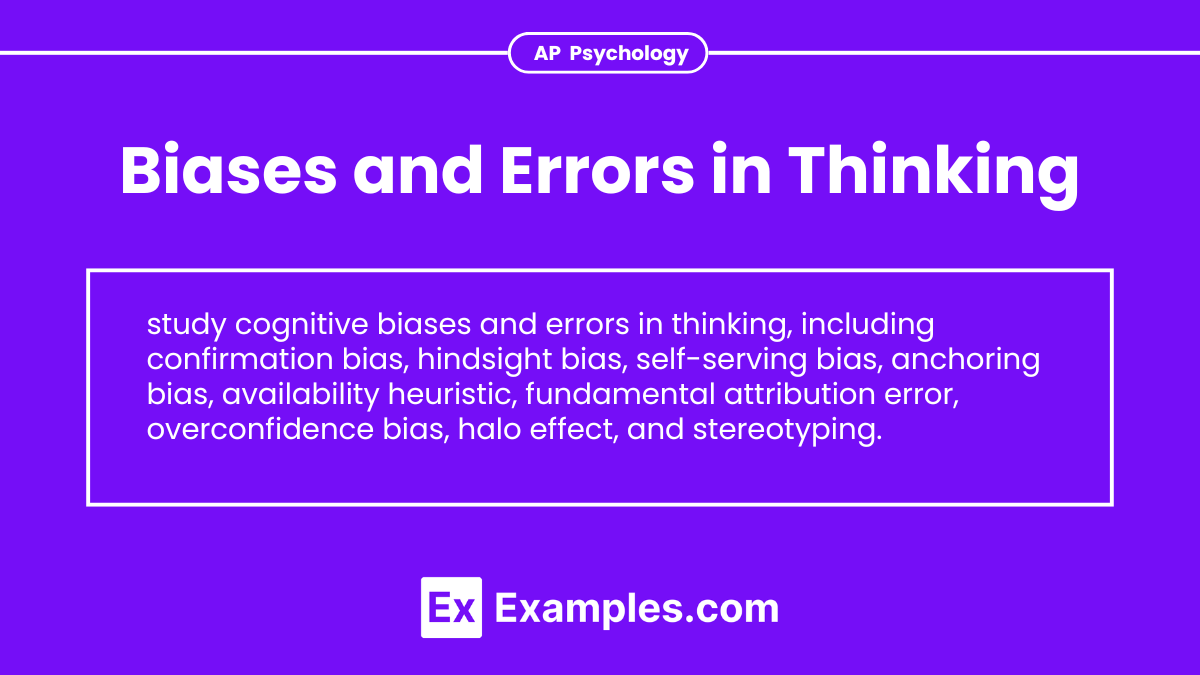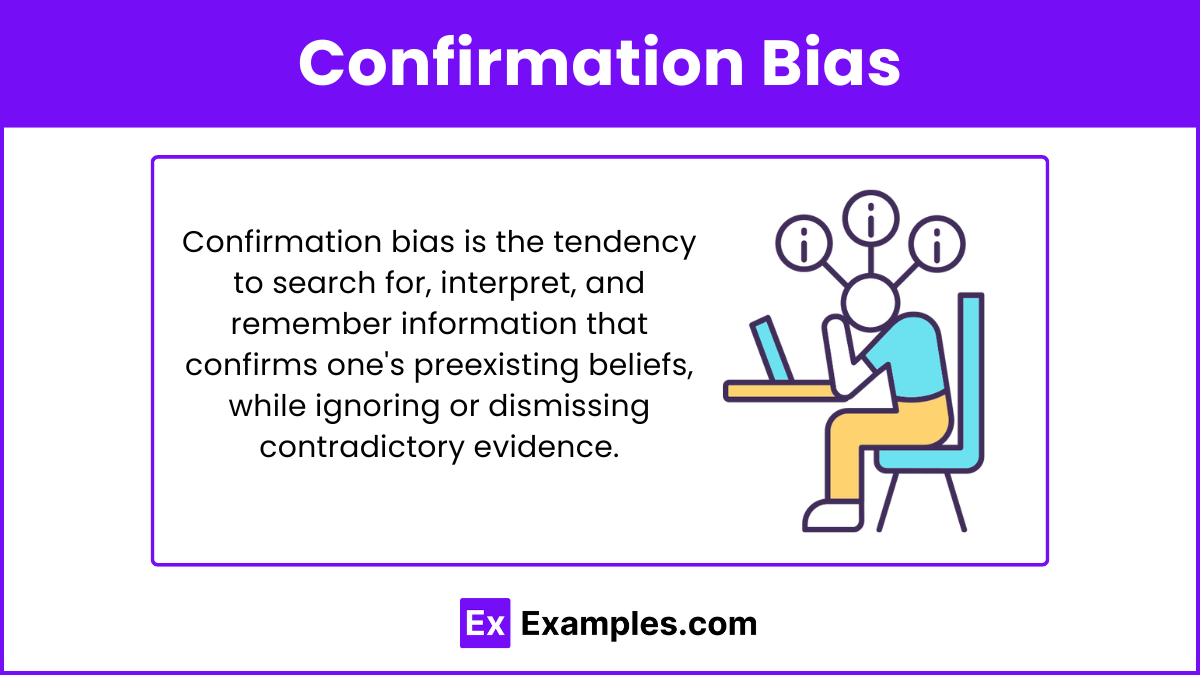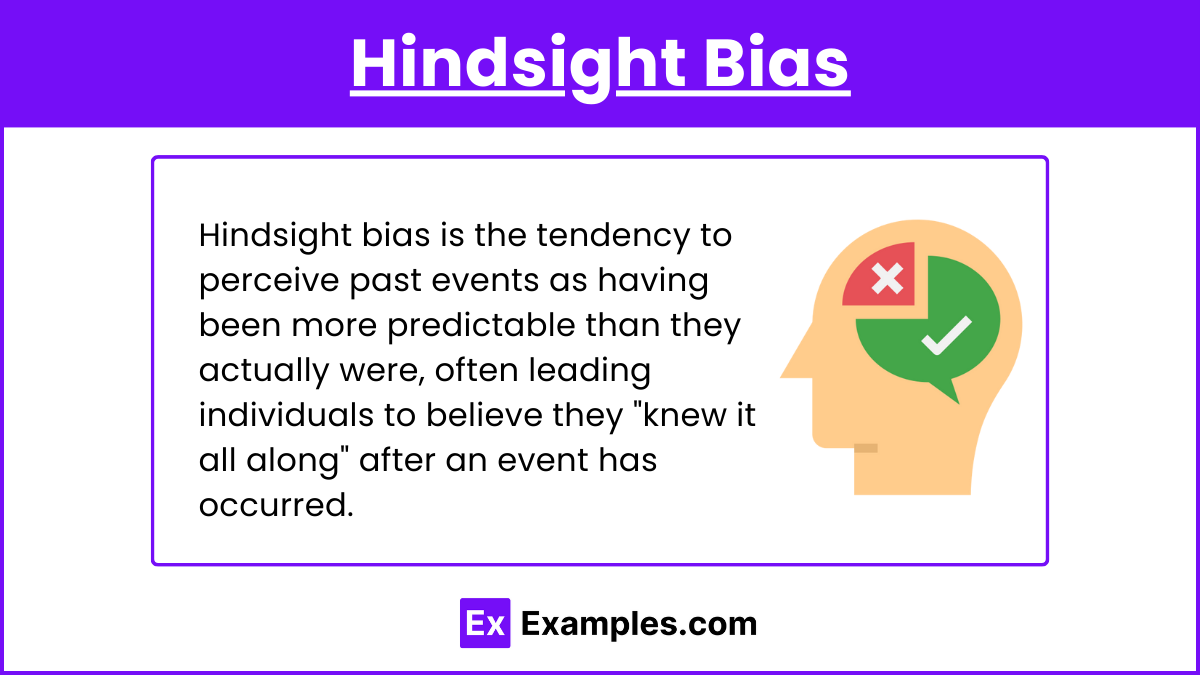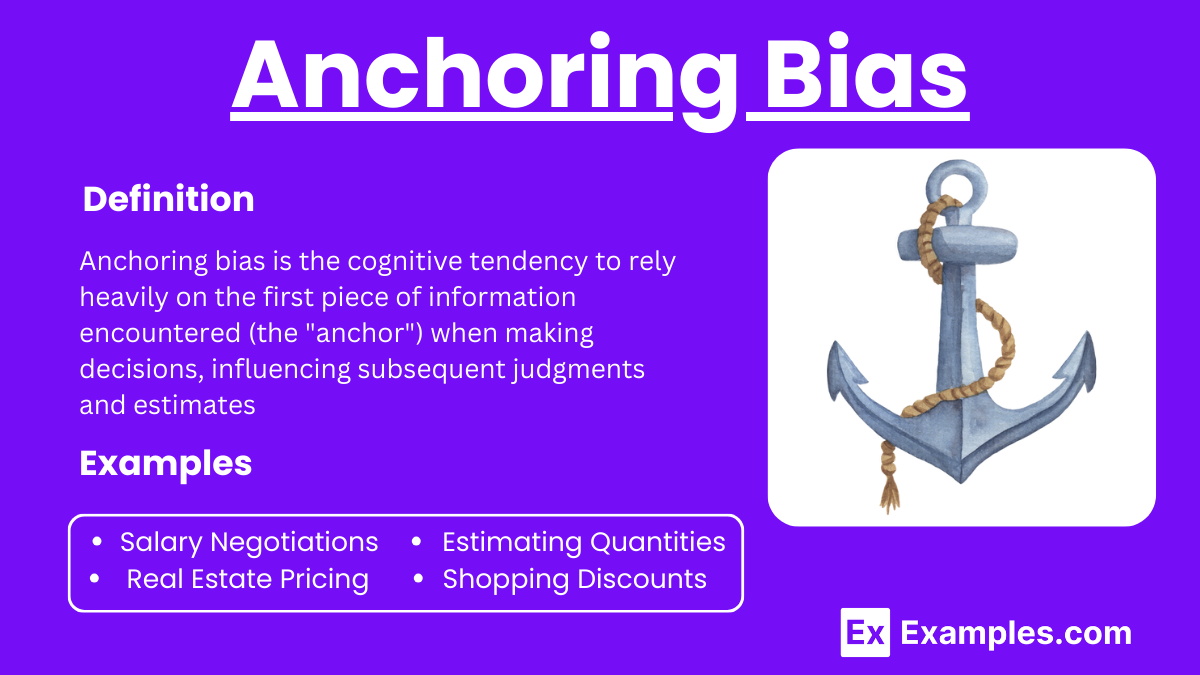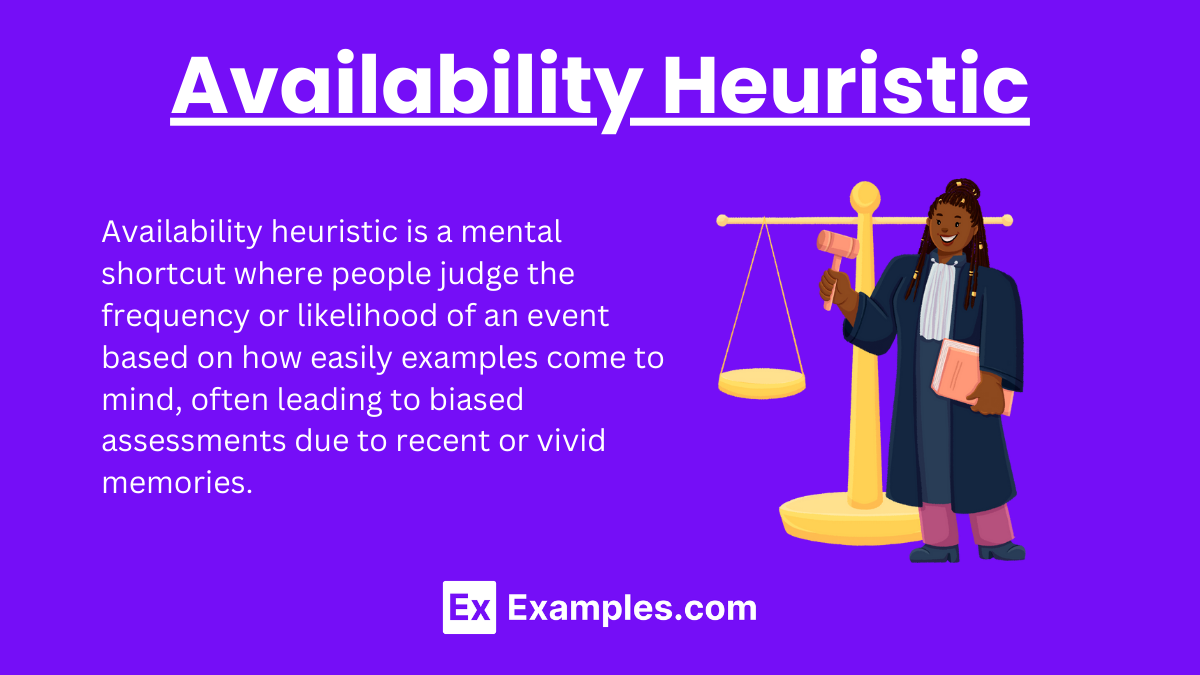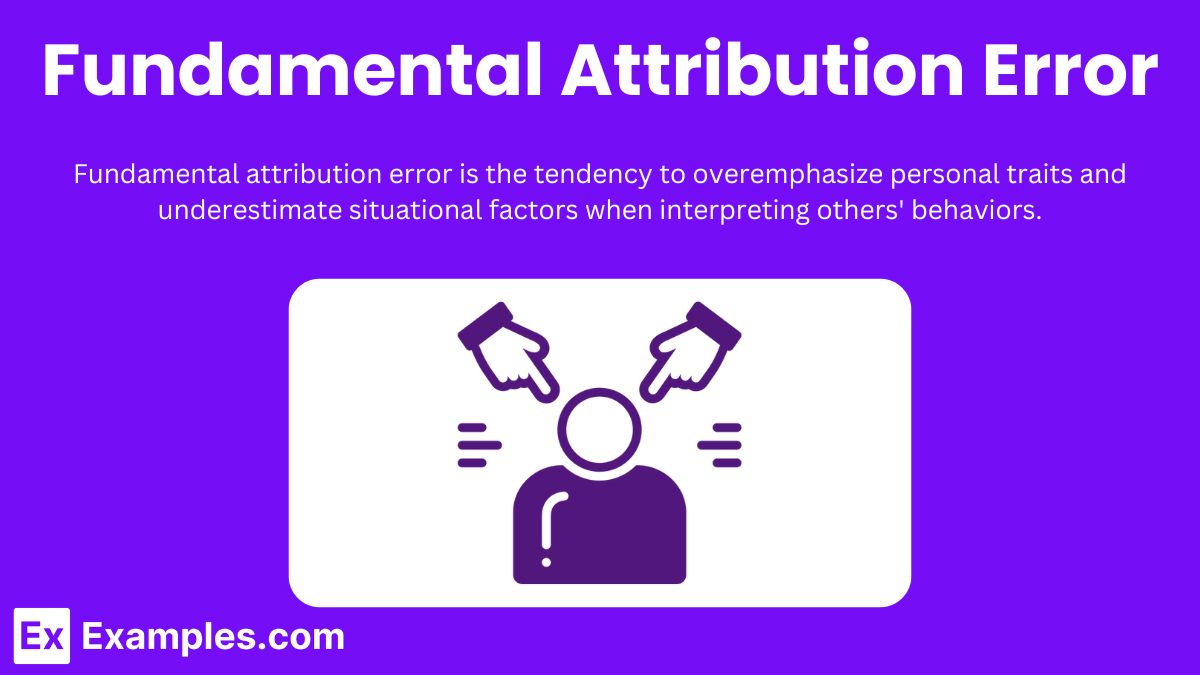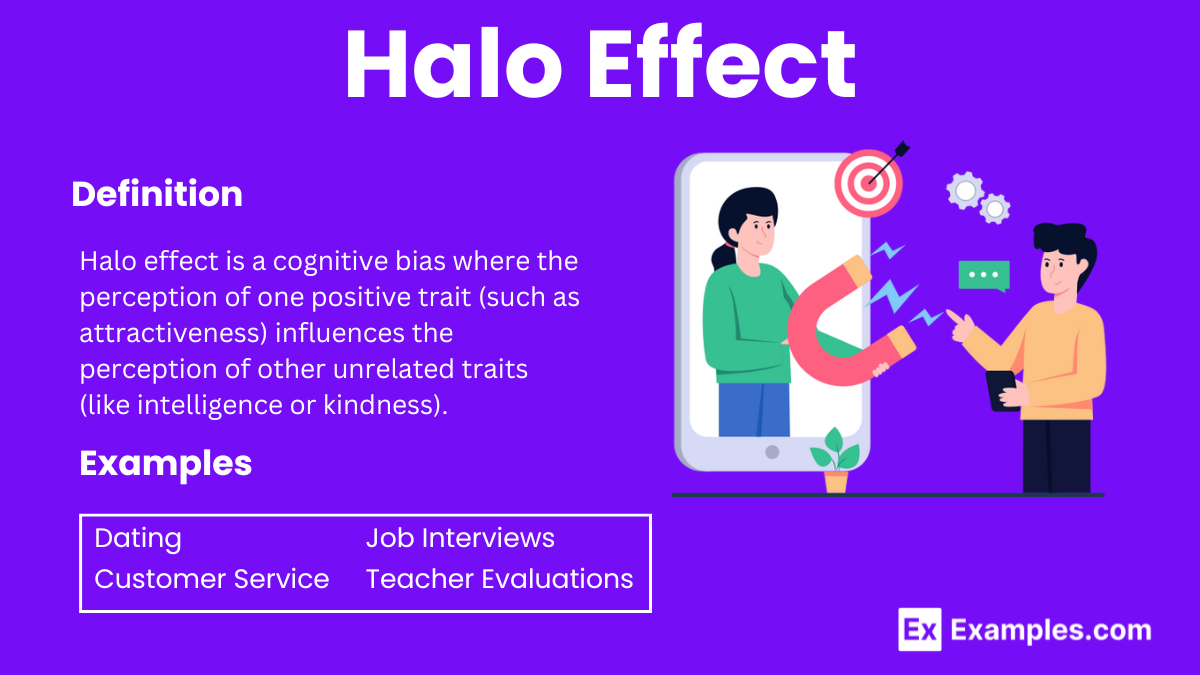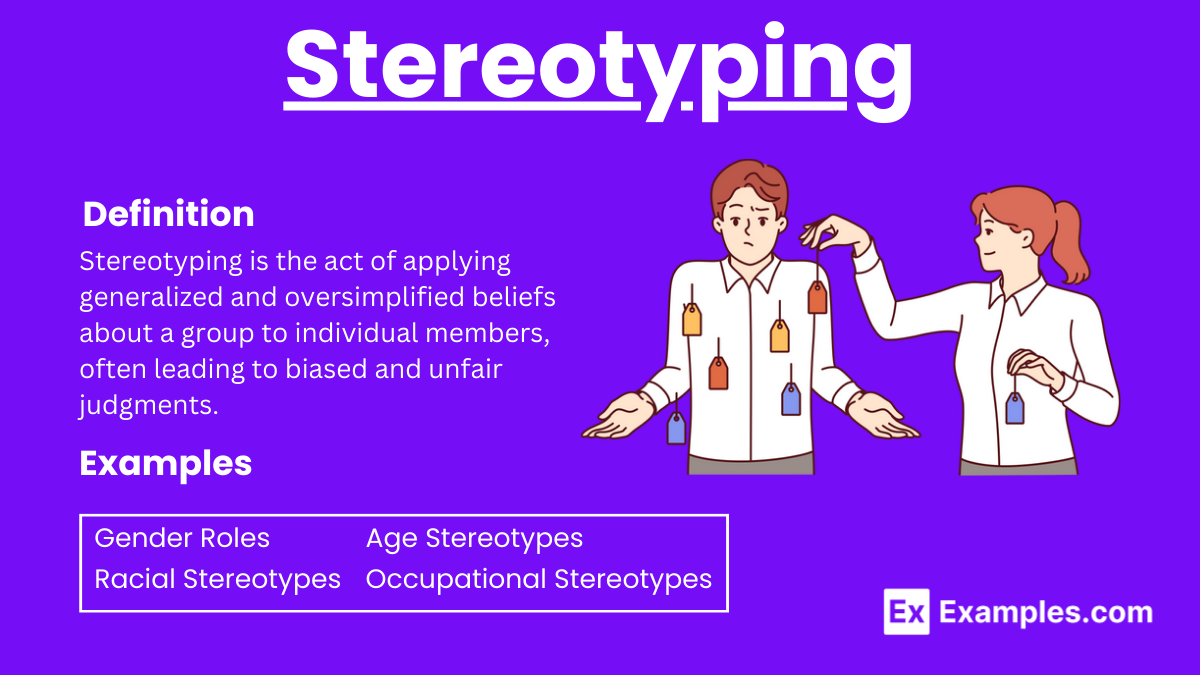Biases and errors in thinking are cognitive distortions that affect how we perceive, interpret, and recall information. These biases, such as confirmation bias, hindsight bias, and the availability heuristic, influence our judgments and decisions in various contexts. Understanding these concepts is crucial for the AP Psychology exam, as it helps students recognize and mitigate their impact on everyday thinking. By studying these cognitive errors, students can enhance their critical thinking skills and make more informed decisions.
Learning Objectives
Understanding key cognitive biases and errors in thinking, including their definitions, examples, and implications. Learn about confirmation bias, hindsight bias, self-serving bias, anchoring bias, availability heuristic, fundamental attribution error, overconfidence bias, halo effect, and stereotyping. Grasp how these biases affect decision-Criteria and judgment in various contexts. Develop the ability to identify these biases in real-world scenarios and explore strategies to mitigate their effects, enhancing critical thinking and analytical skills.
1. Confirmation Bias
Confirmation bias is the tendency to search for, interpret, and remember information that confirms one's preexisting beliefs or hypotheses. It involves giving disproportionately less consideration to alternative possibilities and often ignoring or dismissing contradictory evidence.
Key Features
Selective Information Gathering: Preferring information that supports existing beliefs.
Interpretive Bias: Interpreting ambiguous information as supporting one's beliefs.
Memory Bias: Recalling information that confirms one's beliefs more easily than information that contradicts them.
Examples
Politics:
Scenario: A person who supports a particular political party actively seeks out news articles and social media posts that praise their party while ignoring or discounting sources that criticize it.
Impact: This leads to a skewed perception of political reality, reinforcing their support without critically evaluating opposing viewpoints.
Health and Wellness:
Scenario: Someone who believes in the effectiveness of a specific diet will focus on success stories and positive testimonials while ignoring scientific studies that show mixed or negative results.
Impact: This can result in adherence to potentially ineffective or harmful dietary practices.
Education:
Scenario: A student who believes they are bad at math might notice and remember only their poor test scores, while overlooking instances of successful problem-solving.
Impact: This reinforces their negative self-perception and can lead to decreased motivation and performance.
Psychological Mechanisms
Cognitive Dissonance: People experience discomfort when confronted with information that contradicts their beliefs, leading them to avoid or dismiss such information.
Self-Verification: Individuals seek information that confirms their self-concept to maintain a consistent and stable self-identity.
Social Dynamics: People tend to associate with others who share similar beliefs, creating echo chambers that reinforce confirmation bias.
Implications
Personal Decision-Making
Risk: Confirmation bias can lead to poor decisions based on incomplete or biased information.
Example: An investor might focus only on positive news about a stock they own, ignoring signs of potential trouble.
Scientific Research
Risk: Researchers may unconsciously favor data that supports their hypotheses, leading to biased results and flawed conclusions.
Example: A study on a new drug might highlight successful outcomes while downplaying adverse effects, skewing the perception of its efficacy.
Social and Cultural Impact
Risk: Confirmation bias contributes to the polarization of opinions and the formation of societal divisions.
Example: In debates over controversial issues like climate change, individuals might only consider evidence that supports their stance, leading to increased polarization and reduced dialogue.
2. Hindsight Bias
Hindsight bias, also known as the "knew-it-all-along" effect, is the tendency to believe, after an event has occurred, that one would have predicted or expected the outcome. This bias makes past events seem more predictable than they actually were.
Key Features
Illusion of Predictability: The belief that the outcome of an event was obvious or predictable after the event has occurred.
Memory Distortion: Recollection of previous uncertainties or predictions is altered to fit the known outcome.
Overconfidence: Increased confidence in one's ability to predict outcomes retrospectively.
Examples
Sports:
Scenario: After a team wins a game, a fan claims they knew all along that the team would win, despite having expressed doubts before the game.
Impact: This skews the fan's memory of their initial uncertainty and reinforces their belief in their predictive abilities.
Stock Market:
Scenario: An investor looks back at a market crash and believes they could have predicted it based on previous trends, even though they did not make any such prediction at the time.
Impact: This creates an illusion of control and may lead to overconfidence in future investment decisions.
Academic Performance:
Scenario: A student who performed well on an exam believes they knew the material would be on the test, even though they initially felt unprepared.
Impact: This can lead to overestimating one's study effectiveness and underestimating the need for thorough preparation in the future.
Psychological Mechanisms
Cognitive Dissonance Reduction: People modify their memories of past predictions to align with actual outcomes to reduce the discomfort of cognitive dissonance.
Sense-Making: The need to make sense of the past by seeing it as more orderly and predictable than it was.
Self-Enhancement: Enhancing self-esteem by perceiving oneself as having been knowledgeable or prescient.
Implications
Personal Decision-Making
Risk: Hindsight bias can lead to overconfidence in one's ability to predict future events, resulting in poor decision-making.
Example: A person might take unnecessary risks in investments or business ventures, believing they can foresee market trends.
Learning and Education
Risk: Students may not accurately assess their study methods or understanding of material, believing they had always known what they eventually learned.
Example: This can result in insufficient preparation for future exams, as they underestimate the effort needed to learn new material.
Legal and Medical Fields
Risk: Hindsight bias can affect judgments and decisions in legal and medical contexts, where past outcomes influence perceptions of negligence or decision quality.
Example: In a malpractice case, jurors might believe a doctor should have predicted a patient's adverse reaction, even if the reaction was unforeseeable.
3. Self-Serving Bias
Self-serving bias is the tendency to attribute positive outcomes to one's own character or actions while attributing negative outcomes to external factors. This bias helps maintain and enhance self-esteem and self-image by protecting individuals from the negative implications of their actions.
Key Features
Attribution of Success: Credit for successes is attributed to personal qualities or actions.
Attribution of Failure: Blame for failures is placed on external factors or circumstances.
Ego Protection: Maintains and boosts self-esteem by deflecting negative feedback.
Examples
Academic Performance:
Scenario: A student who receives a high grade on a test attributes their success to their intelligence and hard work. However, if they receive a low grade, they blame the teacher's unfair questions or poor teaching.
Impact: This can lead to a skewed perception of one's abilities and hinder learning from mistakes.
Workplace:
Scenario: An employee who successfully completes a project takes full credit for their skills and effort. If the project fails, they blame insufficient resources or lack of support from colleagues.
Impact: This can create tension in team settings and impede personal growth by ignoring areas needing improvement.
Sports:
Scenario: An athlete attributes winning a game to their skill and training but blames a loss on bad weather or biased referees.
Impact: This can prevent athletes from critically analyzing their performance and improving.
Psychological Mechanisms
Self-Enhancement: Individuals seek to maintain and boost their self-esteem by taking credit for positive outcomes.
Self-Protection: By blaming external factors for failures, individuals protect themselves from the negative impact on their self-image.
Cognitive Dissonance: Reducing discomfort from cognitive dissonance by rationalizing failures as being due to factors beyond one's control.
Implications
Personal Growth and Learning
Risk: Self-serving bias can hinder personal growth by preventing individuals from acknowledging and learning from their mistakes.
Example: A student may not improve their study habits if they blame poor grades on external factors rather than recognizing their lack of preparation.
Interpersonal Relationships
Risk: This bias can strain relationships, as individuals may not take responsibility for their actions, leading to conflicts and misunderstandings.
Example: In a team project, one member might refuse to accept their role in a failure, causing friction with teammates.
Professional Development
Risk: Self-serving bias can impact professional development by limiting one's ability to recognize areas for improvement.
Example: An employee might miss opportunities for growth if they do not acknowledge their shortcomings and seek feedback.
4. Anchoring Bias
Anchoring bias occurs when an individual relies too heavily on an initial piece of information (the "anchor") when making decisions. This initial information acts as a reference point and can influence subsequent judgments and estimates, even if the anchor is arbitrary or irrelevant.
Key Features
Initial Information Influence: The first piece of information serves as a reference point and heavily influences subsequent judgments.
Inadequate Adjustment: People typically make insufficient adjustments away from the anchor, leading to biased decisions.
Persistence of the Anchor: The influence of the anchor persists even when individuals are aware of its potential irrelevance.
Examples
Salary Negotiation:
Scenario: During a job interview, the employer offers an initial salary figure that is lower than the candidate expected. The candidate's counteroffer and final agreed salary are influenced by this initial anchor, even if they believe they deserve more.
Impact: The candidate might settle for a lower salary than they originally anticipated.
Real Estate Pricing:
Scenario: A homeowner lists their house for sale at a high initial price. Potential buyers' offers are influenced by this anchor, leading them to offer amounts closer to the listed price, even if the house is overpriced.
Impact: Buyers might end up paying more than the market value.
Estimating Quantities:
Scenario: When asked to estimate the number of jelly beans in a jar, participants who first hear a high number (anchor) will provide higher estimates than those who hear a low number.
Impact: This leads to biased and often inaccurate estimates.
Psychological Mechanisms
Cognitive Load Reduction: Relying on an anchor reduces the cognitive load by providing a starting point for decision-making.
Heuristic Processing: Anchoring serves as a heuristic or mental shortcut, simplifying complex decision-making processes.
Selective Accessibility: The anchor activates related information in memory, making it more accessible and influential in subsequent judgments.
Implications
Personal Decision-Making
Risk: Anchoring bias can lead to suboptimal decisions by causing individuals to weigh initial information too heavily.
Example: When making a large purchase, such as a car, the initial price quoted by the dealer can influence the buyer’s perception of what constitutes a fair price.
Financial Decisions
Risk: Investors may rely on initial price points when making buying or selling decisions, leading to poor investment choices.
Example: An investor might hold onto a stock because its current price is anchored to its initial purchase price, ignoring more relevant market indicators.
Medical Field
Risk: Anchoring bias can affect medical diagnoses, with initial impressions influencing subsequent evaluations and treatment plans.
Example: A doctor might diagnose a patient based on the initial symptoms reported and overlook other potential diagnoses that don't fit the initial impression.
5. Availability Heuristic
Availability heuristic is a mental shortcut that relies on immediate examples that come to a person's mind when evaluating a specific topic, concept, method, or decision. This heuristic is often used to judge the frequency or likelihood of events based on how easily examples can be recalled from memory.
Key Features
Ease of Recall: Events that are more memorable or recent are perceived as more common or likely.
Salience: Dramatic or vivid events are more easily recalled and thus deemed more frequent.
Impact of Media: Media coverage can amplify the availability of certain events, skewing perceptions of their frequency.
Examples
Risk Assessment:
Scenario: After watching several news reports about airplane crashes, a person might overestimate the danger of flying, despite statistics showing it is safer than driving.
Impact: This leads to an irrational fear of flying and a preference for less safe modes of transportation.
Medical Diagnosis:
Scenario: A doctor might diagnose a patient with a condition they recently encountered frequently, even if other, more likely conditions are possible.
Impact: This can result in misdiagnosis and inappropriate treatment.
Public Perception of Crime:
Scenario: After seeing multiple reports of violent crimes on the news, people might believe that violent crime rates are higher than they actually are.
Impact: This can lead to increased fear and anxiety, influencing public policies and personal behaviors.
Psychological Mechanisms
Memory Recall: Events that are easily recalled are often those that are recent, vivid, or emotionally charged.
Frequency Misjudgment: The ease with which examples come to mind influences judgments about the frequency or probability of those events.
Media Influence: Extensive media coverage makes certain events more available in memory, skewing perceptions of their actual frequency.
Implications
Personal Decision-Making
Risk: The availability heuristic can lead to poor decision-making by causing individuals to overestimate the likelihood of rare but memorable events.
Example: Someone might choose to avoid swimming in the ocean due to fear of shark attacks, which are extremely rare.
Public Policy and Perception
Risk: Policymakers might prioritize issues that are more salient in public memory, even if data shows they are less critical.
Example: Excessive focus on terrorism prevention, despite statistically higher risks from other causes of death like heart disease or traffic accidents.
Medical and Health Decisions
Risk: Doctors might make biased decisions based on recent or memorable cases rather than statistically common conditions.
Example: Overprescribing antibiotics for viral infections due to memorable cases of bacterial complications.
6. Fundamental Attribution Error
Fundamental Attribution Error (FAE) is the tendency to overemphasize personal characteristics and ignore situational factors when judging others' behavior. This bias leads to attributing others' actions to their character while underestimating the influence of external circumstances.
Key Features
Dispositional Attribution: Overemphasizing personality traits and characteristics as the cause of behavior.
Underestimation of Situational Factors: Ignoring or downplaying the impact of external, situational influences on behavior.
Bias in Judgment: This error often results in unfair assessments of others’ actions.
Examples
Workplace Behavior:
Scenario: If a colleague misses a deadline, you might think they are lazy or incompetent, without considering that they may be dealing with personal issues or an unusually heavy workload.
Impact: This can lead to misunderstandings and conflict in the workplace, as situational factors are overlooked.
Driving Incidents:
Scenario: When another driver cuts you off in traffic, you might assume they are an aggressive or reckless driver, without considering that they might be rushing to an emergency.
Impact: This snap judgment can lead to road rage and a lack of empathy for other drivers.
Academic Performance:
Scenario: A teacher might think a student is unmotivated or unintelligent if they perform poorly on a test, without considering factors such as test anxiety, personal problems, or lack of study resources.
Impact: This can result in unfair treatment of the student and a failure to address the real issues affecting their performance.
Psychological Mechanisms
Perceptual Salience: The person’s behavior is more noticeable than the surrounding context, leading to an overemphasis on dispositional factors.
Cognitive Load: Attributing behavior to personality traits requires less cognitive effort than considering complex situational factors.
Cultural Influences: Individualistic cultures, which emphasize personal responsibility and autonomy, are more prone to FAE compared to collectivist cultures.
Implications
Interpersonal Relationships
Risk: Fundamental Attribution Error can damage relationships by leading to misunderstandings and unfair judgments.
Example: Assuming a friend is thoughtless because they missed your birthday party, without considering they might have had an unavoidable conflict.
Workplace Dynamics
Risk: This error can result in unfair evaluations of colleagues and employees, affecting teamwork and morale.
Example: A manager might think an employee is not committed to their job due to occasional lateness, ignoring potential external factors like transportation issues.
Legal and Social Judgments
Risk: FAE can influence judicial outcomes and social policies by attributing criminal behavior to inherent traits rather than situational factors.
Example: Judges and juries might be harsher on defendants perceived as having bad character, regardless of mitigating circumstances.
7. Overconfidence Bias
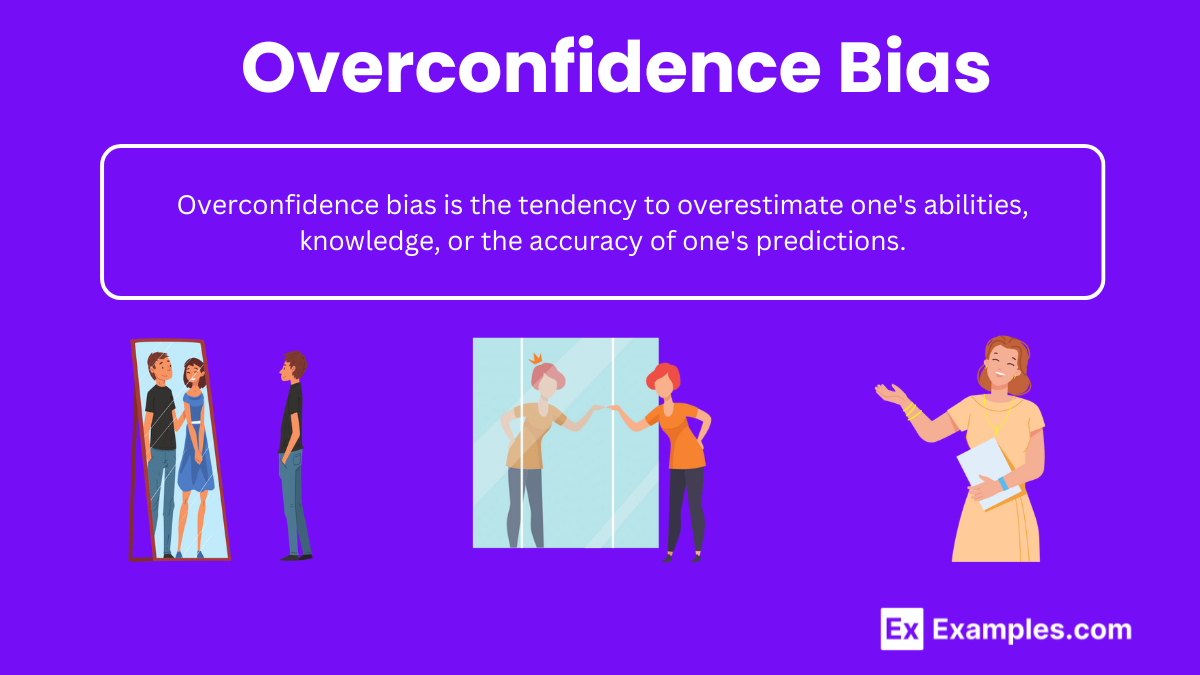
Overconfidence bias is the tendency to overestimate one's abilities, knowledge, and the accuracy of one's predictions. This cognitive bias leads individuals to believe they are more capable or knowledgeable than they actually are, often resulting in poor decision-making and risk-taking.
Key Features
Overestimation: Overestimating one's performance or abilities.
Overprecision: Being excessively certain about the accuracy of one's beliefs or predictions.
Overplacement: Believing oneself to be better than others in specific areas.
Examples
Academic Performance:
Scenario: A student might believe they understand the material thoroughly and thus do not study enough for an exam, resulting in a lower score than anticipated.
Impact: This can lead to poor academic performance and a misunderstanding of one's true abilities.
Financial Decisions:
Scenario: An investor may be overly confident in their ability to predict stock market movements, leading to risky investments and potential financial losses.
Impact: Overconfidence in investing can result in significant financial losses and poor portfolio management.
Project Management:
Scenario: A project manager might be overly confident in their team's ability to meet deadlines without considering potential obstacles, resulting in project delays.
Impact: This can lead to unmet deadlines, increased costs, and reduced project quality.
Psychological Mechanisms
Self-Enhancement: Individuals seek to maintain a positive self-image and boost their self-esteem by believing they are more capable than they are.
Confirmation Bias: Overconfident individuals may seek out information that supports their beliefs and ignore information that contradicts them.
Cognitive Dissonance: Overconfidence helps reduce cognitive dissonance by justifying one's actions and decisions as being more rational or correct than they might be.
Implications
Personal Decision-Making
Risk: Overconfidence can lead to poor personal decisions by underestimating risks and overestimating one's control over outcomes.
Example: Someone might choose to drive in hazardous conditions, believing their driving skills are superior to most people's.
Professional Development
Risk: Overconfidence can hinder professional growth by leading individuals to ignore feedback and miss opportunities for improvement.
Example: An employee might refuse additional training, believing they already possess all necessary skills, resulting in stagnation.
Health and Safety
Risk: Overconfidence in one's physical abilities can lead to taking unnecessary risks, resulting in injury.
Example: An athlete might push themselves beyond safe limits, believing they are invulnerable to injury.
8. Halo Effect
The halo effect is a cognitive bias in which our overall impression of a person influences how we feel and think about their character. Essentially, the perception of one positive trait (such as attractiveness) can create a "halo" that positively influences our judgments about other unrelated traits (such as intelligence or kindness).
Key Features
Single Trait Influence: A single positive trait heavily influences overall perception.
Generalization: Positive impressions in one area lead to assumptions of positive traits in other areas.
Implicit Bias: Often occurs subconsciously, without deliberate reasoning.
Examples
Workplace Evaluations:
Scenario: An employee who is exceptionally punctual is perceived as more competent and reliable overall, regardless of their actual job performance.
Impact: This can lead to biased performance reviews and unfair advancement opportunities.
Educational Settings:
Scenario: A student who is well-behaved and attentive in class is assumed to be more intelligent and capable, even if their academic performance does not support this assumption.
Impact: Teachers might give them higher grades or more opportunities based on behavior rather than actual academic ability.
Consumer Behavior:
Scenario: A customer perceives a brand with attractive packaging as being higher quality or more trustworthy, regardless of the product’s actual effectiveness.
Impact: This can lead to purchasing decisions based more on packaging than product quality.
Psychological Mechanisms
First Impressions: Initial positive impressions are powerful and tend to persist, influencing subsequent judgments.
Consistency Seeking: People prefer to see consistency in others' behaviors and traits, leading them to extend their positive impressions from one area to another.
Cognitive Simplification: The halo effect simplifies cognitive processing by reducing the need to evaluate each trait individually.
Implications
Personal Relationships
Risk: The halo effect can lead to unrealistic expectations and misunderstandings in personal relationships.
Example: Assuming someone is kind and trustworthy based solely on their attractive appearance can lead to disappointment if their behavior does not match these expectations.
Professional Environments
Risk: This bias can result in unfair evaluations and decision-making in hiring, promotions, and task assignments.
Example: A manager might favor a charismatic employee for leadership roles, even if other employees have better qualifications and experience.
Judicial and Legal Settings
Risk: The halo effect can affect judgments about defendants, witnesses, and attorneys, potentially leading to biased legal outcomes.
Example: A well-dressed, articulate defendant might be perceived as more credible and less guilty than a less polished individual, regardless of the evidence.
9. Stereotyping
Stereotyping is the act of oversimplifying and generalizing attributes, behaviors, or traits of a group to its individual members. This cognitive bias involves forming an opinion about someone based on perceived group characteristics rather than personal attributes.
Key Features
Generalization: Applying broad characteristics to all members of a group.
Simplification: Reducing complex human behaviors and attributes to simple, often exaggerated, traits.
Assumption-Based: Making judgments about individuals based on assumed group traits rather than individual evidence.
Examples
Racial Stereotypes:
Scenario: Believing that all members of a specific race possess certain traits, such as assuming all Asians are good at math.
Impact: This can lead to unfair expectations and discrimination against those who do not fit the stereotype.
Gender Stereotypes:
Scenario: Assuming that women are more nurturing and men are more assertive.
Impact: Such stereotypes can influence career opportunities and societal roles, limiting personal and professional growth.
Age Stereotypes:
Scenario: Believing that older individuals are not tech-savvy or that younger people are irresponsible.
Impact: This can result in age-based discrimination in hiring practices and social interactions.
Psychological Mechanisms
Cognitive Efficiency: Stereotypes simplify the complex nature of social interactions by categorizing people into groups, making it easier to process information.
In-Group Bias: Favoring one's own group while viewing others as homogeneous and different, reinforcing stereotypes.
Confirmation Bias: Seeking out information that confirms existing stereotypes while ignoring contradictory evidence.
Implications
Personal Relationships
Risk: Stereotyping can hinder the development of meaningful relationships by preventing individuals from seeing others as unique individuals.
Example: Avoiding social interactions with people based on stereotypes about their group can limit personal growth and understanding.
Workplace Dynamics
Risk: Stereotypes can lead to biased hiring practices, unequal opportunities, and workplace discrimination.
Example: Assuming that a woman is less capable of handling a leadership role because of gender stereotypes can limit diversity and innovation.
Social and Cultural Impact
Risk: Stereotyping perpetuates social inequalities and reinforces systemic discrimination.
Example: Media portrayal of certain groups based on stereotypes can shape public perception and policy, leading to institutional bias and marginalization.

